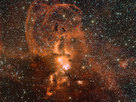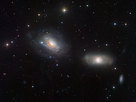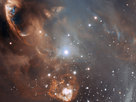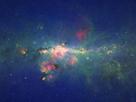Pandora’s Cluster
Pandora’s Cluster phenomena
When the astronomers looked at the results they found many curious features. “Abell 2744 seems to have formed from four different clusters involved in a series of collisions over a period of some 350 million years. The complicated and uneven distribution of the different types of matter is extremely unusual and fascinating,” says Dan Coe, the other lead author of the study.
It seems that the complex collision has separated out some of the hot gas and dark matter so that they now lie apart from each other, and from the visible galaxies. Pandora’s Cluster combines several phenomena that have only ever been seen singly in other systems.
Near the core of the cluster is a “bullet”, where the gas of one cluster collided with that of another to create a shock wave. The dark matter passed through the collision unaffected [1].
In another part of the cluster there seem to be galaxies and dark matter, but no hot gas. The gas may have been stripped away during the collision, leaving behind no more than a faint trail.
Even odder features lie in the outer parts of the cluster. One region contains lots of dark matter, but no luminous galaxies or hot gas. A separate ghostly clump of gas has been ejected, which precedes rather than follows the associated dark matter. This puzzling arrangement may be telling astronomers something about how dark matter behaves and how the various ingredients of the Universe interact with each other.
Galaxy clusters are the biggest structures in the cosmos, containing literally trillions of stars. The way they form and develop through repeated collisions has profound implications for our understanding of the Universe. Further studies of the Pandora’s Cluster, the most complex and fascinating merger yet found, are in progress.
Notes
[1] This effect has been seen before in a few galaxy cluster collisions, including the original "Bullet Cluster", 1E 0657-56
Quelle: ESO
Pandora’s Cluster
Pandora’s Cluster phenomena
When the astronomers looked at the results they found many curious features. “Abell 2744 seems to have formed from four different clusters involved in a series of collisions over a period of some 350 million years. The complicated and uneven distribution of the different types of matter is extremely unusual and fascinating,” says Dan Coe, the other lead author of the study.
It seems that the complex collision has separated out some of the hot gas and dark matter so that they now lie apart from each other, and from the visible galaxies. Pandora’s Cluster combines several phenomena that have only ever been seen singly in other systems.
Near the core of the cluster is a “bullet”, where the gas of one cluster collided with that of another to create a shock wave. The dark matter passed through the collision unaffected [1].
In another part of the cluster there seem to be galaxies and dark matter, but no hot gas. The gas may have been stripped away during the collision, leaving behind no more than a faint trail.
Even odder features lie in the outer parts of the cluster. One region contains lots of dark matter, but no luminous galaxies or hot gas. A separate ghostly clump of gas has been ejected, which precedes rather than follows the associated dark matter. This puzzling arrangement may be telling astronomers something about how dark matter behaves and how the various ingredients of the Universe interact with each other.
Galaxy clusters are the biggest structures in the cosmos, containing literally trillions of stars. The way they form and develop through repeated collisions has profound implications for our understanding of the Universe. Further studies of the Pandora’s Cluster, the most complex and fascinating merger yet found, are in progress.
Notes
[1] This effect has been seen before in a few galaxy cluster collisions, including the original "Bullet Cluster", 1E 0657-56
Quelle: ESO










